KTH Transformation Day tackled Circular Economy
Event summary
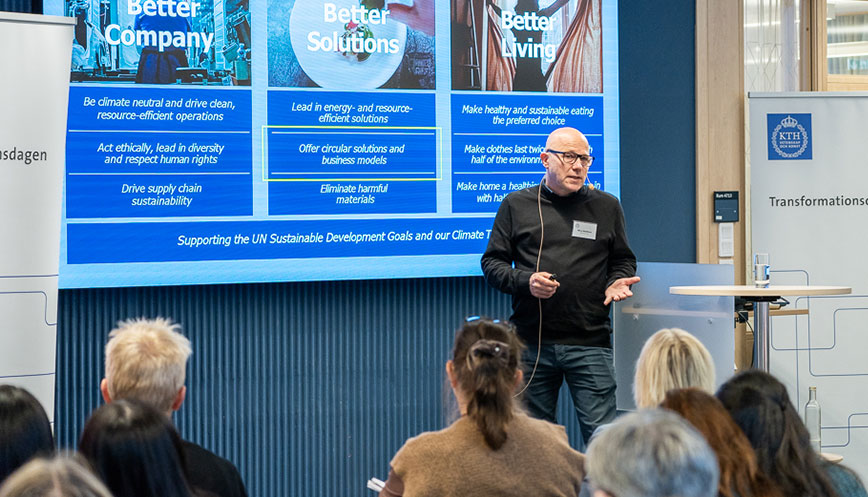
On 19 October 2023, KTH’s Transformation Day “Industry transforms towards circular economy” addressed the subject of the Circular Economy. The aim of the event was to bring together leading industry profiles with researchers and professors at KTH and highlight some of the many initiatives being undertaken by both parties. In addition, to explore the possibilities of tighter cooperation between business and academia in this field.
The event, arranged by KTH’s
Industrial Transformation Platform
, was opened by
Platform Directors Monica Bellgran, Kerstin Forsberg and Martin Grimheden, who head up the research platform at the university. Welcoming the 100-plus guests and speakers to the event, Bellgran presented the agenda for the day and explained how the KTH platform is a great way to bring together different actors to address societal challenges.
“Our approach from day one has been, ‘how do we at KTH contribute and support industries’ transformation?’,” said Monica Bellgran. “We decided this year to take on Circular Economy because we understand that we have been living in a linear society for 100 years, and we need to change it to a circular one. CE is a really important issue at KTH, and events like today’s will help us raise its profile and hopefully attract more researchers to the subject.”
How can academia and industry boost the circular economy?

Clearly, one key factor in the success of the ongoing climate transformation will be how academia and industry can find answers to the biggest challenge of our lifetime. KTH Professor Amir Rashid laid out the issue in the most succinct way possible.
“We’re here because of sustainability challenges. We, humans, are the first and only 'intelligent' species practising linear economy on a circular planet, and soon we’ll be the last to have practised it! The problem with the linear model is that we’re producing and consuming more and more – circularity could provide the solution,” Amir Rashid said.
Session 1: A Systematic View of Circular Economy
The first session of the day focused on the gravity of the problem and what companies are already doing about it.
KTH’s Amir Rashid laid out the challenge facing society in terms of resource consumption, waste management, material extraction, CO2 emissions and the economic model of “producing more, consuming more”. On an upbeat note, he stressed that circularity is nature’s solution to creating value for life on our planet.
Michael Lieder, Business Developer, Circular Economy at Scania CV, kicked things off by presenting the importance of circularity in the transport ecosystem in general and, more specifically, Scania’s business model.
“We’re behind in terms of collection and dismantling, and we don’t have the ecosystem in the same way as we do in the forward flow, Michael Lieder said. “But If we develop here, it will enable more loops and more circularity.”
With that in mind, Michael Lieder introduced the company’s iReGear project, in which Scania is looking at introducing remanufactured gearboxes into newly produced vehicles. By reusing, Scania can make cost savings, lower its carbon footprint, and make material savings, he said.
Barry Waddilove, Head of Circular Economy and Partnerships at the Electrolux Group, talked about balancing the needs of meeting consumer demand and taking a circular approach to business. He outlined the nine goals the Group has set based on being a better company, finding better solutions and providing better living, as well as supporting the UN Sustainable Development Goals and Climate Targets. He introduced Electrolux’s AtEase subscription-based service, whereby consumers can have new or refurbished products which can later be regenerated, and the company’s partnership with Stena recycling, one of the main aims of which is to design a 90 per cent recyclable vacuum cleaner.
Maryna Henrysson, from the Energy Technology Department at KTH, illustrated how three self-inflicted planetary crises: Climate change, biodiversity loss, and pollution, are combining to degrade Earth’s capacity to sustain human well-being. Because energy systems power the linear economy, we are trapped in a circle whereby increased energy demand pushes material demand, and material demand leads to increased energy demand, she said.
The answer is to push renewable energy and move more towards material-intensive energy systems, she said. Above all, we need to rethink on every level, invest in innovation and knowledge creation, and invest in knowledge sharing and cooperation across society.
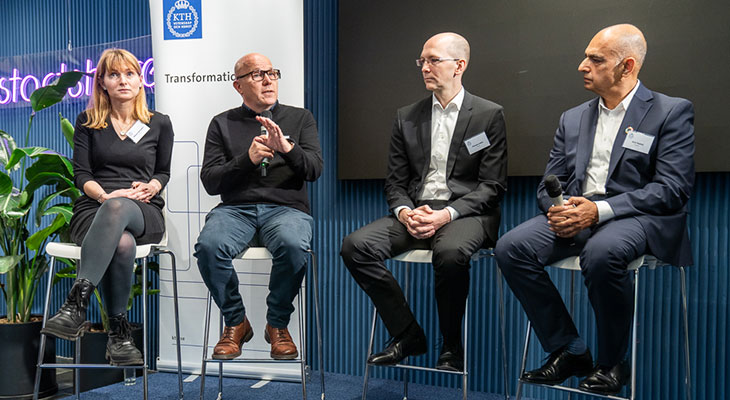
The panel then discussed issues that arose from the presentations and wider questions from the floor. Among the topics covered were Maryna Henrysson’s conflicted feelings about batteries and the Northvolt and green steel factories in Canada, the ongoing gap between climate targets and the need for greater communication over the size of that gap is, and where we are on the scale of a linear to circular economy.
When asked about where we are in terms of the wider transition, Barry Waddilove from Electrolux talked of the huge potential in re-industry (repair, refurbishing, etcetera) and what we have seen from the textile industry, with huge re-sellers like Depop. He also pointed out the refurbishing of mobile phones as another area that has seen enormous growth in recent times.
Michael Lieder at Scania suggested that in terms of changing our mindset, we’re still only at the beginning. “We need to build partnerships with startups and universities, and industry has to collaborate better with society,” he concluded.
Session 2: Circular innovations
The second session of the day, moderated by Magnus Wiktorsson, saw representatives from Volvo and Stora Enso join two more KTH researchers to discuss Circular Innovations.
In her introduction, Katarina Colliander, Circular Business Developer at Volvo Group, took the opportunity to point out that even though Volvo has been involved in remanufacturing for over 70 years, they are still operating a linear business model and always keen to find more ways to be circular, not least with EATS (Exhaust AfterTreatment System). Remanufacturing is being undertaken at eight production facilities spread all over the world, meanwhile, and staff at every level are encouraged to participate in CE awareness sessions and join communities. Katarina Colliander also stressed the need for collaborations and partnerships, something Volvo has undertaken with SKF around the handling of ball bearings.
“The challenge is always to enlarge creative thinking throughout the organisation. What can we do differently? We are programmed to the linear model, so we need to rethink,” she concluded.
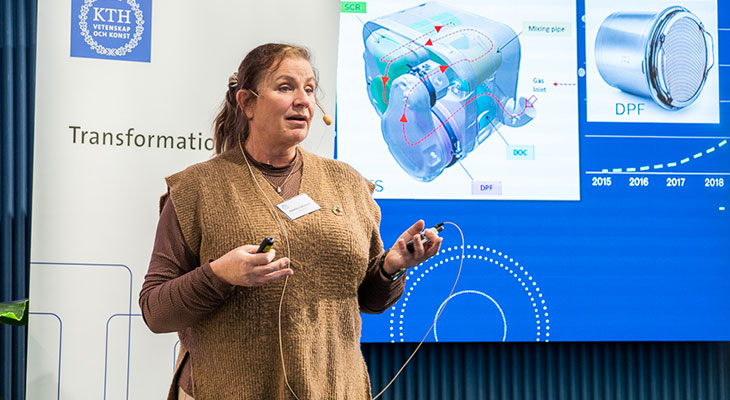
Mikael Hannus, Senior Vice President of Group Innovation R & D at Stora Enso, talked about the company’s ambition to achieve 100 per cent recyclable products by 2030. Their renewable products are circular by design, he said, adding that even by 2022, Stora Enso had reached technical recyclability of products of some 94 per cent.
He then laid out the five ways in which Stora Enso intend to achieve growth through innovation; Enhancing the circularity of biomaterials; taking the lead on innovation for barriers; Partnering with customers for co-creation; Growing expertise in converting solutions, and finally, leveraging design and NBD (new business development) capabilities.
“We replace non-renewable raw materials with renewable products, and thanks to our sustainability approach, we have already had a high recycling rate for a long time. Our purpose is to do good for people and the planet,” Mikael Hannus said.
KTH Professor Sofia Ritzén talked about the challenges faced by many businesses in the climate transition and, more specifically, the fundamental issues presented by resource loops in traditional linear business models. The traditional model has been the Slow (use longer) – Close (use again), Regenerate (Make clean), and Narrow (use less), she said. The problem for companies is that slowing down can lead to less sales, closing can cut revenues, and regenerating can increase costs. Sofia Ritzén also stressed the challenges caused by unfairness – the unfair distribution of resources in society today, both in the world along with an unevenly distributed volume of global pollution

In his talk on Innovation eco-systems and business models, Andreas Feldmann, KTH Associate professor in Industrial Engineering and Management, argued that for the transition to a Circular economy to be a success, it will require new partnerships to complement competencies and roles and also to help spread risks. A new competitive landscape is also necessary, he added, so that competing parties can help spur innovation mutually. Using Sweden as an example, Andreas Feldmann pointed out the ways in which he and his team of researchers at KTH are working with new industries and helping to construct new ecosystems. This, he is confident, is the way forward, adding, “We constantly need new relations and new actors, but also perhaps even more, we need people just to talk more about everyday issues.”
The panel discussion following the presentations began with the need for more actors involved in the coordination of all kinds of data around the circular economy. Different actors can also mean more partners, Katarina Colliander added – but not just any partner, said Mikael Hannus “We need to look into what kind of roles each actor will play, based on their core competencies and capabilities. You need to be an expert to have your place in the ecosystem.” Volvo’s Katarina Colliander gave an insight into the Collage project that aims to increase awareness among employees at every level with a card-based “game” that is being rolled out across the company.
Session 3: Enabling technology for Circular Economy
After a networking lunch based on “One Planet Plate,” the group reconvened for the first of the afternoon sessions – “Enabling technology for Circular Economy.”
Roman Chirikov, Product Development Leader at Ericsson, kicked things off with a session on “Enabling Circular economy.” Underlining the potential in digitalisation, he said how ICT solutions will help level up industries in the future and laid out Ericsson’s ambition to reduce emissions and ultimately reach Net Zero by 2030. He then described three more ways in which they will help pioneer a sustainable future across society; Halve emissions by 2030 and increase climate action in global supply chains; Develop and innovate their portfolio to halve emissions by 2030; and Decarbonize industries and society globally through ICT solutions.
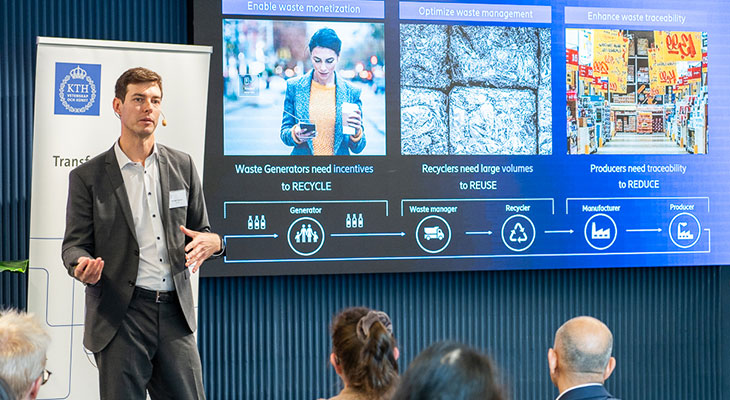
Metal cutting giant Sandvik Coromant was represented by Martin Helgoson, Function Expert and Technology Area Manager and Senior Sustainability Expert Amari Enzi. Again, stressing the huge potential of digitalisation, they outlined Sandvik’s own goal to close the loop for all materials and recondition or recycle them into new resources. By 2030 Sandvik Coromant hopes to reach more than 90% circularity for their products, packaging and waste. Like many others at the event today, Martin Helgoson and Amari Enzi spoke of the need to collaborate with other actors and the role that ICT solutions will have, moving forward.
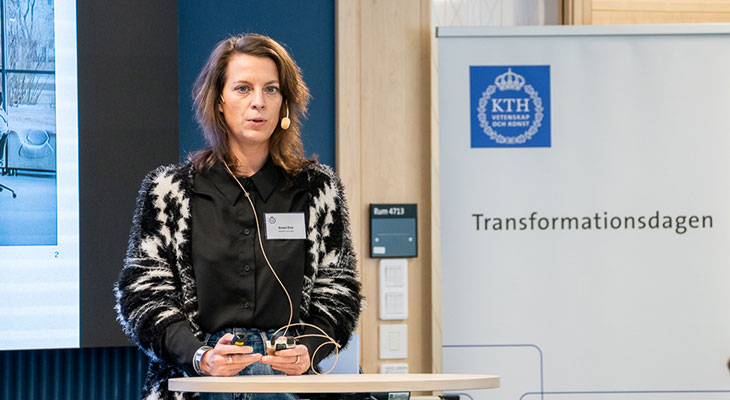
Farazee Asif, Assistant Professor and Docent at KTH, presented a scenario on how AI can help support deciding the future viability of used printers. Currently, more than 80 per cent of Lexmark printers are sold with the option to sell back at the EoL/EoU, but as there is no access to embedded usage information in the printers, there is uncertainty over whether those bought back can be remanufactured. With the help of DiCiM development, AI generates the right purchase price that supports the business model and determines if the printers are fit for remanufacturing, part recovery or recycling.
In his presentation, “Cyber-physical systems as CE enablers – capabilities, risks and needs,” KTH Researcher Martin Törngren discussed the many ways in which CPS can support a circular economy as we shift to a system where we regenerate natural systems, design out waste and pollution, and keep products and materials in use. Using a raft of technologies like RFID, UWB, NFC, edge and cloud computing, software, data and machine learning/AI, Identification, monitoring and tracing will improve, as will product/service design and service-based business models. He also outlined the risks of an overreliance on increasingly complex CPS, and automation surprises and pitfalls. “What we have to do is make things simple and have new methodologies,” Martin Törngren countered.
That point was brought up in the discussion that followed the presentations. According to Electrolux’s Barry Waddilove, one of the issues is that with so much emergent technology, some of it is good, some less so. As a result, it’s hard, he said, for big companies to invest in complex systems. Ericsson’s Roman Chirikov agreed that complexity is still an issue and hinted at the game-changing potential of using solar-powered mobile devices. Sandvik’s Amari Enzi talked of the importance of learning the “right” problems and determining what is missing. “Does the technology or solution actually solve the problem or not? And if not, why?” she asked.
Session 4 What happens now – Where do we go from here?
The final session looked at how we, as individuals, can make a difference in our society and what KTH can do to provide further support for our industries.
Jenni Grute, Secretary General of the Föreningen Medveten Konsumtion, introduced the concept of a “Cirkulent” and how these conscious consumers can enable the sustainable transition. A Cirkulent, she explained, sees need and function over desire. In practice, this means employing methods such as reusing items, repairing, borrowing, swapping, renting, buying things second-hand, and recycling. In short – rethinking. If you do everything except buy new items, she argued, you will gain a deeper appreciation of the things you have. “And If 25 per cent lead the way, the rest will follow.”
In her talk on “Reflections about collaboration and increased interdisciplinarity,” Annika Borgenstam, Vice President for Research at KTH, presented some of the many ways in which academia, and KTH especially, is collaborating with industry, and what improvements are still needed. Like many others, she stressed the need for more partnerships. “We have to aim for more collaboration, co-creation and dissemination of knowledge and to develop arenas for dialogue and collaboration,” she said. Annika Borgenstam then outlined some of the strategic partnerships already in place, KTH’s research infrastructures, the university’s Research Centres (of which there are over 50), and how they can tackle issues by collaborating, building competence and providing a dedicated meeting place for innovation.
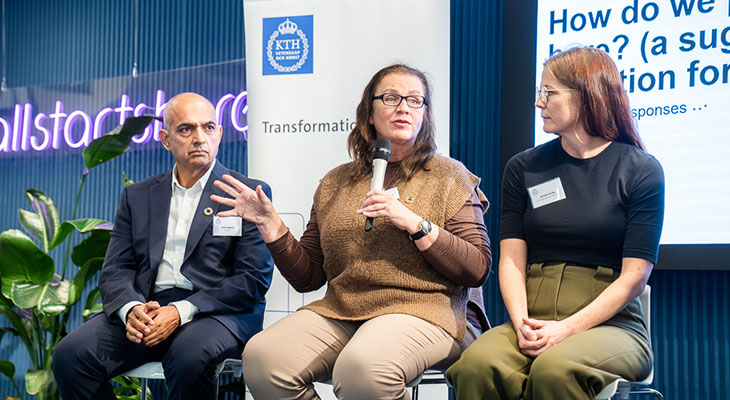
For the final panel discussion, Barry Waddilove from Electrolux, Katarina Colliander, Circular Business Developer, Volvo Group, and Amir Rashid, Professor KTH returned to the stage to answer questions from moderator Martin Grimheden and the audience. Among the issues covered were how KTH can be more interdisciplinary, how closely Volvo designers work with suppliers on circular issues, and what kind of incentives it will take in the future, both for companies and consumers, to change their habits. “If you can change one behaviour to help the environment, it’s easier to take steps two and three,” concluded Jennie Grute.
As for KTH, “We have a large responsibility towards sustainability and society in the climate transition. And we should be pleased to have that responsibility. We know we need to do more interdisciplinary work and we are discussing it, but we know it’s not easy, and it takes time,” Annika Borgenstam said.
As for final thoughts on the future from the others, Amir Rashid believes topic-based research is key, more challenge-driven platforms and ecosystems can be the future direction. “Simplicity is key and we have to use all the tools at our disposal and bring them together at an early stage,” said Volvo’s Katarina Colliander, while Jennie Grute concluded, “We must collaborate with consumers because they are so aware of the problems and they have ideas on how to solve their problems.”
- Short news article about the event
- Interviews with Ericsson, Scania, and Volvo
- The conducted program
Text: Geoff Mortimore
